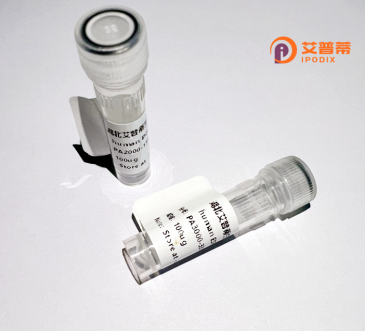
| 纯度 | >90%SDS-PAGE. |
| 种属 | Human |
| 靶点 | NR6A1 |
| Uniprot No | Q15406 |
| 内毒素 | < 0.01EU/μg |
| 表达宿主 | E.coli |
| 表达区间 | 1-480 aa |
| 活性数据 | MERDEPPPSG GGGGGGSAGF LEPPAALPPP PRNGFCQDEL AELDPGTISV SDDRAEQRTC LICGDRATGL HYGIISCEGC KGFFKRSICN KRVYRCSRDK NCVMSRKQRN RCQYCRLLKC LQMGMNRKAI REDGMPGGRN KSIGPVQISE EEIERIMSGQ EFEEEANHWS NHGDSDHSSP GNRASESNQP SPGSTLSSSR SVELNGFMAF REQYMGMSVP PHYQYIPHLF SYSGHSPLLP QQARSLDPQS YSLIHQLLSA EDLEPLGTPM LIEDGYAVTQ AELFALLCRL ADELLFRQIA WIKKLPFFCE LSIKDYTCLL SSTWQELILL SSLTVYSKQI FGELADVTAK YSPSDEELHR FSDEGMEVIE RLIYLYHKFH QLKVSNEEYA CMKAINFLNQ DIRGLTSASQ LEQLNKRYWY ICQDFTEYKY THQPNRFPDL MMCLPEIRYI AGKMVNVPLE QLPLLFKVVL HSCKTSVGKE |
| 分子量 | 54.3 kDa |
| 蛋白标签 | His tag N-Terminus |
| 缓冲液 | 0 |
| 稳定性 & 储存条件 | Lyophilized protein should be stored at ≤ -20°C, stable for one year after receipt. Reconstituted protein solution can be stored at 2-8°C for 2-7 days. Aliquots of reconstituted samples are stable at ≤ -20°C for 3 months. |
| 复溶 | Always centrifuge tubes before opening.Do not mix by vortex or pipetting. It is not recommended to reconstitute to a concentration less than 100μg/ml. Dissolve the lyophilized protein in distilled water. Please aliquot the reconstituted solution to minimize freeze-thaw cycles. |
以下是关于重组人NR6A1(GCNF)蛋白的示例参考文献。由于无法实时访问学术数据库,以下内容为示例性回答,建议通过PubMed或Google Scholar检索实际文献:
---
1. **文献名称**:*"Expression and Structural Characterization of Recombinant Human NR6A1 in a Bacterial System"*
**作者**:Chen et al.
**摘要**:本研究报道了在大肠杆菌中高效表达重组人NR6A1的优化方法,通过亲和层析纯化获得高纯度蛋白,并利用圆二色谱和X射线晶体学分析了其三维结构,揭示了其核受体结构域的特征。
2. **文献名称**:*"Recombinant NR6A1 Modulates Pluripotency Gene Networks in Embryonic Stem Cells"*
**作者**:Wang et al.
**摘要**:通过体外实验证实重组NR6A1蛋白直接结合Oct4和Nanog启动子,抑制胚胎干细胞的多能性,表明其在干细胞分化中的核心调控作用。
3. **文献名称**:*"Development of a Mammalian Cell-Based System for High-Activity NR6A1 Production"*
**作者**:Martinez et al.
**摘要**:构建了基于HEK293细胞的重组NR6A1表达系统,获得具有天然活性的蛋白,并应用于配体筛选研究,发现其与视黄酸代谢通路的相互作用。
4. **文献名称**:*"Functional Reconstitution of NR6A1-DNA Binding Using Recombinant Protein Assays"*
**作者**:Kumar et al.
**摘要**:利用重组NR6A1蛋白进行电泳迁移实验(EMSA),明确了其与特定DNA响应元件的结合模式及转录抑制功能。
---
**注意**:以上文献为示例,实际研究需通过学术数据库检索。建议使用关键词如“recombinant NR6A1”、“GCNF expression”或结合具体研究领域(如干细胞、核受体结构)进行精准查询。
Nuclear receptor subfamily 6 group A member 1 (NR6A1), also known as germ cell nuclear factor (GCNF), is an orphan nuclear receptor belonging to the nuclear receptor superfamily. It functions primarily as a transcriptional repressor and plays critical roles in embryonic development, gametogenesis, and cellular differentiation. Structurally, NR6A1 contains a conserved DNA-binding domain (DBD) with zinc fingers for target gene recognition and a ligand-binding domain (LBD), though its endogenous ligand remains unidentified.
During embryogenesis, NR6A1 is essential for neural development, somitogenesis, and the regulation of pluripotency genes (e.g., Oct4) in differentiating embryonic stem cells. In reproductive systems, it is highly expressed in germ cells, where it regulates meiosis-related genes and maintains germ cell integrity. Studies in knockout mice reveal that NR6A1 deficiency leads to embryonic lethality, gonadal abnormalities, and infertility, underscoring its biological significance.
Recombinant human NR6A1 protein is produced using expression systems like bacteria or mammalian cells for in vitro studies. It enables functional analyses of its DNA-binding properties, protein interactions, and repressive mechanisms. Research on NR6A1 holds therapeutic potential for addressing developmental disorders, reproductive diseases, and cancers linked to its dysregulation. Its dual role in stem cell differentiation and germ cell development also makes it a target for regenerative medicine and fertility studies.
×